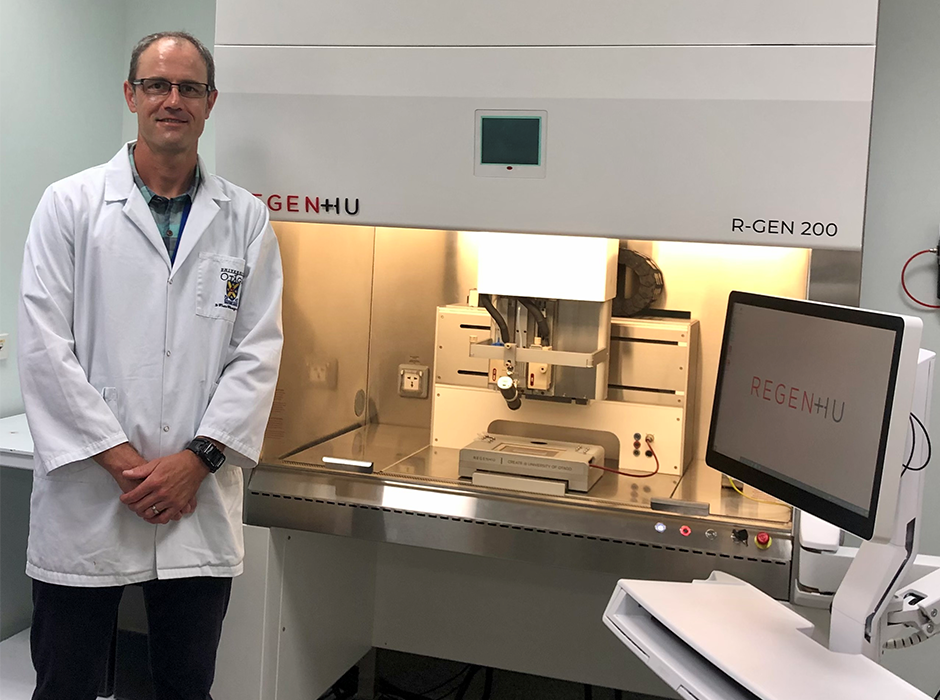
Professor Tim Woodfield, Director, CReaTE, standing alongside the REGENHU R-GEN 200 3D Bioprinter.
A cutting-edge research team at the University of Otago, Christchurch has been chosen as an international partner in a major European Union (EU) HORIZON-funded consortia project focussed on advancing 3D bioprinting and regenerative medicine.
The Christchurch Regenerative Medicine and Tissue Engineering (CReaTE) group, which sits in the campus’s Department of Orthopaedics and Musculoskeletal Medicine, is the only university in Aotearoa New Zealand involved in a 50 million euro EU HORIZON research project on “Bioprinting of Living Cells for Regenerative Living”, as part of a specific HORIZON-HEALTH call focussed on “Tools and Technology for a Healthy Society”.
Professor of Regenerative Medicine and CReaTE Director Tim Woodfield says his team will play a major role in an eight million euro micro@MACRO (m2M) project - tasked with advancing the exciting field of bioprinting technology for cartilage tissue repair in human patients. It will bring together leading academic institutions, research centres, and companies to create a system for producing personalised, scalable grafts to support the repair of damaged tissues.
“This is fantastic and exciting news, recognising not only a decade of our hard work but highlighting the strength of Otago’s research in the interdisciplinary fields of bioengineering, bio-printing and regenerative medicine,” Tim says.
“By making this significant commitment, the EU recognises that advancing stem cell technology and developing new clinical treatments using a patient’s own regenerative tissue is the way of the future for medicine.
“It also recognises that to meet this grand challenge, advanced biomaterials and bioprinting technologies are required to automate cell manufacturing and effectively deliver cell therapies at scale and in cost-effective ways.”
The m2M project was one of only six bids accepted out of a total of 80 consortia projects submitted to this EU HORIZON call. CReaTE will receive funding support from both EU HORIZON and MBIE (here in New Zealand) over the four-year project.
Trinity College Dublin (Ireland) will lead the research collaborative, alongside the University of Otago/CReaTE, the University College Dublin (Ireland), the University Medical Centre Utrecht (Netherlands), the University of Helsinki (Finland), the University Hospital Wurzburg (Germany) and the University of Basel (Switzerland), along with five consortia partners from the European regenerative medicine manufacturing industry.
"What’s really exciting with this research is the likelihood of incorporating patients' cells into the 3D printing process to regenerate their tissue rather than replacing it with an orthopaedic implant,” Tim says.
“While cartilage has limited regenerative capacity and few clinical approaches are capable of restoring long-term function to damaged or diseased cartilage, we are developing techniques to effectively manufacture and automate the biofabrication of such tissues at scale from a patient's own cells. We harness our pioneering work in modular assembly of living tissue units - tissue Lego-like, if you will.”
CReaTE has been honing its technique using custom-made 3D printers, laying down cells and bioinks, layer by layer, to produce complicated, intricate objects.
"Rather than taking individual cells and joining them together, we are making 'microtissues' or little spheres of tissue about a millimetre or less and containing about half a million cells each,” Tim explains.
"We make thousands of these tissue spheroids at a time and assemble them in layers using our 3D bioprinter and novel cartilage and bone bioinks, to build strong tissue. The goal is to automate these processes so that the bio-printed construct can then be surgically implanted into patients, and this has led to exciting developments so far.
“We are thrilled to be international partners in this consortia project by contributing our novel bioinks and bio assembly expertise, as well as being acknowledged by our European colleagues and the EU HORIZON programme.”
University of Otago Deputy Vice-Chancellor Research and Enterprise, Professor Richard Blaikie, says CReaTE’s involvement with the EU Horizon project is a major coup.
“We congratulate Tim and his team on their success in this highly competitive process. This project will not only advance international understanding into one of the most exciting fields of medical research, but also put University of Otago technology in front of a number of major biotech and regenerative medical companies throughout Europe,” Richard says.
“The programme fits well with the government strategy for research science and innovation to contribute to economic growth and productivity. Importantly, the outcomes will also improve lives through new medical technologies and therapies. We wish the team every success in the work that lies ahead.”
Tim, who is also an External Expert Advisory Board (EEAB) member for another one of the six funded EU HORIZON projects, says plans for CReaTE to move into the new Christchurch campus building Wai Ora upon its completion early next year - with its state-of-the-art 3D bioprinting facility - will accelerate this collaborative effort and support the team’s growth even further.